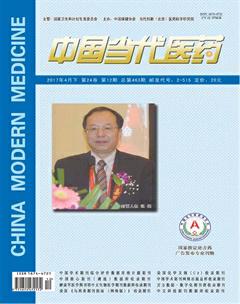甲状腺未分化癌的遗传学改变研究进展
赵佳正
[摘要]甲状腺未分化癌是一种恶性程度很高的肿瘤,区别于分化型甲状腺癌,常规的手术、放疗及化疗治疗效果较差。随着甲状腺未分化癌分子发病机制的不断研究,许多遗传学改变都被认为参与了甲状腺未分化癌发生、发展的过程,为甲状腺未分化癌的分子靶向治疗提供了新的可能。本文将介绍与甲状腺未分化癌发病相关的遗传学改变的研究进展,主要包括RAS/RAF/MAPK/ERK信号通路和PI3K/Akt mTOR信号通路。
[关键词]甲状腺未分化癌;分子机制;基因
[中图分类号] R736.1 [文献标识码] A [文章编号] 1674-4721(2017)04(c)-0016-04
[Abstract]As a highly malignant tumor,anaplastic thyroid carcinoma is different from differentiated thyroid cancer,conventional surgery,radiotherapy and chemotherapy can achieve poor results in the treatment of thyroid undifferentiated carcinoma.With the unceasing research on molecular pathogenesis of anaplastic thyroid carcinoma,many genetic changes are thought to be involved in the development process of anaplastic thyroid carcinoma and to provide a new possibility for molecular targeted treatment of thyroid undifferentiated carcinoma.In this paper,the research progress of the genetic changes related to the pathogenesis of anaplastic thyroid carcinoma is introduced,including RAS/RAF/MAPK/ERK signaling pathway and PI3K/Akt mTOR signaling pathway.
[Key words]Anaplastic thyroid carcinoma;Molecular mechanism;Gene
近年來甲状腺癌的发病率不断上升,已经成为最常见的内分泌肿瘤[1]。根据甲状腺癌病理组织类型,可分为乳头状甲状腺癌(papillary thyroid cancer,PTC)、滤泡状甲状腺癌(follicular thyroid cancer,FTC)、低分化型甲状腺癌(poorly differentiated thyroid cancer,PDTC)和甲状腺未分化癌(anaplastic thyroid carcinoma,ATC),其中PTC和FTC又被称为分化型甲状腺癌(differentiated thyroid cancer,DTC)。ATC是一种恶性程度很高的肿瘤,在所有甲状腺癌中占2%~15%,导致了绝大多数的甲状腺癌相关死亡,中位生存期为6个月,临床表现为迅速增长的颈部肿块,常常伴随压迫症状[2-3]。ATC常具有高度侵袭性,容易发生腺体外侵犯及淋巴结转移,60%的患者有远处转移,ATC的TNM分期均为Ⅳ期[3]。在过去的几十年中,ATC生存的改善微乎其微[4],也正因为如此,对ATC分子发病机制的研究就显得尤为重要。研究人员试图通过遗传学改变的研究找到治疗ATC的新途径。
甲状腺癌恶性程度进展被认为是一个多步骤的肿瘤发生过程,甲状腺滤泡细胞早期发生的RAS、BRAF导致分化型甲状腺癌的发生,而p53基因失活突变导致了细胞进一步失分化而出现甲状腺低分化癌(PDTC)和ATC[5]。与ATC发生相关的基因组改变主要包括RAS/RAF/MAPK/ERK信号通路、PI3K/Akt mTOR信号通路[5-6],下面将按照遗传学改变的类型(基因突变、基因重排和基因拷贝数增加)分类阐述。
1基因突变
1.1 Ras突变
Ras家族包括K-ras、H-ras及N-ras,Ras位于RAF/MAPK及PI3K/Akt mTOR的上游,Ras突变会导致这两条通路异常活化[7]。RAS突变常见于滤泡性甲状腺癌,但在PTC和ATC中也有报道[8]。在对甲状腺癌的组织病理研究中,发现高达60%的ATC出现Ras突变,而在PTC中突变率<15%,PDTC中突变率为30%~35%[9],可见Ras突变频率与分化程度成负相关。在甲状腺癌发展的过程中,RAS似乎是一个“早期”突变,RAS突变被认为启动了DTC到ATC这个去分化过程,因为RAS突变会使细胞发生基因和分子错排,例如导致染色体不稳定[10]。
1.2 BRAF突变
RAF家族包括ARAF、BRAF和CRAF 3种亚型。BRAF是Raf丝氨酸/苏氨酸激酶家族中的一员,是Ras的下游效应器,在正常甲状腺细胞增殖、凋亡及甲状腺特异基因表达中起重要的调节作用[11]。研究显示,大鼠甲状腺细胞中BRAF基因突变及随后的MAPK的活化能沉默钠/碘协同转运体(sodium/iodide symporter,NIS)的表达,而通过siRNA去除BRAF突变可以恢复甲状腺特异性基因的表达[12],BRAFV600E突变被证实会阻碍NIS基因的表达以及NIS的膜定位,而通过抑制BRAF,可逆转NIS转录抑制[12]。BRAFV600E突变可导致DTC细胞中甲状腺特异蛋白表达下调,促进去分化,还与转移和侵袭相关[13]。基于BRAF突变在DTC以及DTC转化成ATC中发挥重要作用,BRAF突变成为治疗ATC的研究靶点[14]。
1.3 PI3K突變
磷脂酰肌醇3-激酶(phosphatidylinositol 3-kinage,PI3K)为脂激酶家族,参与细胞增殖、存活。磷脂酰肌醇3-激酶/蛋白激酶B/哺乳动物雷帕霉素靶蛋白(phosphatidylinositol 3-kinage/protein kinase B/mammaliantarget of rapamycin,P13K/Akt mTOR)信号通路与ATC的发生、发展密切相关[15],其中的PI3K突变是最常见的突变,ATC中PI3K突变发生的频率远高于PTC[7]。PI3K突变可通过抑制cAMP而降低NIS表达,使得甲状腺癌细胞向未分化方向发展,同时PI3K突变可上调下游的mTOR含量,mTOR可促进细胞增殖、抑制细胞凋亡,mTOR又可以降低NIS表达[16]。
1.4 p53突变
p53是一种抑癌基因,编码的蛋白质分子量为53 kDa,是一种转录因子,p53抑癌基因在调节细胞周期和细胞凋亡中的起重要作用[17]。p53基因在DTC中突变频率低而在ATC中突变频率可高达95%,在并发PTC和ATC的病理组织中,可在ATC组织中检测到p53突变,而在PTC中检测不到[18]。有学者提出了“两步机制”,甲状腺癌中,在BRAF突变的细胞基础上发生p53基因的突变,使得肿瘤失分化,p53突变的出现是一个晚期事件,其使得肿瘤转化和去分化而变得更具侵略性[19-20]。目前,针对p53的靶向治疗已成为研究热点。
1.5 β-catenin基因突变
β-catenin是一种多功能蛋白分子,分布于细胞质中,高达60%~65%的ATC中存在β-catenin突变[21]。在ATC中,β-catenin基因突变主要涉及Wnt/β-catenin通路以及与E-cadherin/β-catenin相关的细胞黏附系统。β-catenin在细胞增殖和细胞黏附中都发挥作用。Wnt/β-catenin通路中过度表达的β-catenin会进入细胞核内,引起细胞持续增殖;E-cadherin/β-catenin的细胞黏附系统中β-catenin突变会使细胞间黏附力减弱,进而增加肿瘤细胞的侵袭性[22]。
1.6 Notch
Notch受体(Notch1-4)及其配体不同情况下可调节细胞的增殖,迁移、黏附和分化[23]。Ferretti等[24]首次证实,与正常甲状腺组织相比,Notch在DTC中表达明显降低,而在ATC中进一步降低,Notch 1对细胞生长和分化的影响是通过调控基因转录来实现。虽然在其他组织和癌症中有许多研究,但Notch 1在甲状腺癌中的作用最近才被探索。作为Notch 1下游效应分子,Hes 1在甲状腺细胞增殖和分化中起中心作用,在Hes 1(-/-)小鼠胚胎中,甲状腺表面积减少了34%~65%,NIS蛋白减少69%[25]。
1.7 NF-κB
核因子κB(NF-κB)属于转录因子家族,可被多种促炎细胞因子、化疗药物和电离辐射激活[26]。许多NF-κB靶基因是促生存基因,对癌细胞固有的化疗和放射治疗抵抗至关重要,体外和体内各种肿瘤细胞包括甲状腺癌在内的研究中,通过抑制NF-κB活性会导致细胞凋亡或增强化疗和放射治疗的敏感性[27]。在PTC、FTC及ATC中均发现NF-κB被激活,因此,抑制NF-κB的活化被认为可通过肿瘤细胞的内在和外在机制加强化疗和放射治疗的作用[28]。
2基因重排
RET原癌基因位于染色体10q11.21,其包含了21个外显子,编码一跨膜的络氨酸激酶受体,包含了1114个氨基酸[29]。目前文献共报道了13种甲状腺癌 RET/PTC基因重排,发生RET/PTC基因重排后会导致RET基因的持续活化,进而活化下游的RAS基因,RET/PTC基因重排会导致染色体不稳定,使细胞失分化[30]。另一个常见的易位是TRK-fused(TFG)和受体酪氨酸激酶NTRK 1,类似于RET的染色体重排,一些TFG的融合蛋白同样会导致MAPK激酶过度激活[31]。
3基因拷贝数增加
受体酪氨酸激酶(receptor tyrosine kinase,RTK)是最大的一类酶联受体,包括了50余种,而常见的表皮生长因子受体(epidermal growth factor receptor,EGFR)、血小板生长因子受体(platelet-derived growth factor receptor,PDGFR)、血管内皮生长因子受体(vascularendothelial growth factor receptor,VEGFR)等突变与多种肿瘤的发生相关[32]。在ATC中,RTK的突变并不常见,但RTK基因拷贝数的增加较为常见。一项研究发现,ATC中发生相应基因拷贝数增加的频率分别为:EGFR 46.3%,PDGFR 23.9%,VEGFR 45.5%,而PIK3C基因拷贝数增加的频率为38.3%[33]。
总之,ATC恶性程度高,预后差,至今仍未找到较好的治疗手段,传统的手术、化疗、放疗效果都不理想,而分子机制的研究发现,ATC中存在多种基因突变及基因异常扩增,这些分子机制的研究或许能为该病的治疗提供新的思路。
[参考文献]
[1]Haugen BR,Alexander EK,Bible KC,et al.2015 American thyroid association management guidelines for adult patients with thyroid nodules and differentiated thyroid cancer:the American Thyroid Association Guidelines Task Force on Thyroid Nodules and Differentiated Thyroid Cancer[J].Thyroid,2016,26(1):1-133.
[2]馮影,高明.94例甲状腺未分化癌临床分析[J].天津医科大学学报,2008,14(2):207-209.
[3]Smallridge RC,Ain KB,Asa SL,et al.American thyroid association guidelines for management of patients with anaplastic thyroid cancer[J].Thyroid,2012,22(11):1104-1139.
[4]Bisof V,Rakusic Z,Despot M.Treatment of patients with anaplastic thyroid cancer during the last 20 years:whether any progress has been made?[J].Eur Arch Otorhinolaryngol,2015,272(7):1553-1567.
[5]Xu B,Ghossein R.Genomic landscape of poorly differentiated and anaplastic thyroid carcinoma[J].Endocr Pathol,2016, 27(3):205-212.
[6]Lennon P,Deady S,Healy ML,et al.Anaplastic thyroid carcinoma:failure of conventional therapy but hope of targeted therapy [J].Head Neck,2016,38(1):E1122-E1129.
[7]Santarpia L,El-Naggar AK,Cote GJ,et al.Phosphatidylinositol 3-kinase/akt and ras/raf-mitogen-activated protein kinase pathway mutations in anaplastic thyroid cancer[J].J Clin Endocrinol Metab,2008,93(1):278-284.
[8]Gupta N,Dasyam AK,Carty SE,et al.RAS mutations in thyroid FNA specimens are highly predictive of predominantly low-risk follicularpattern cancers[J].J Clin Endocrinol Metab,2013,98(1),E914-E922.
[9]Basolo F,Pisaturo F,Pollina LE,et al.N-ras mutation in poorly differentiated thyroid carcinomas:correlation with bone metastases and inverse correlation to thyroglobulin expression[J].Thyroid,2000,10(1):19-23.
[10]Howell GM,Hodak SP,Yip L.RAS mutations in thyroid cancer[J].Oncologist,2013,18(2):926-932.
[11]Rushton S,Burghel G,Wallace A,et al.Immunohistochemical detection of BRAF V600E mutation status in anaplastic thyroid carcinoma[J].Histopathology,2016,69(2):524-526.
[12]Riesco-Eizaguirre G,Rodríguez I,De la Vieja A,et al.The BRAFV600E oncogene induces transforming growth factor beta secretion leading to sodium iodide symporter repression and increased malignancy in thyroid cancer[J].Cancer Res,2009,69(21):8317-8325.
[13]Lim AM,Taylor GR,Fellowes A,et al.BRAF inhibition in BRAFV600E-positive anaplastic thyroid carcinoma[J].J Natl Compr Canc Netw,2016,14(3):249-254.
[14]Latteyer S,Tiedje V,Konig K,et al.Targeted next-generation sequencing for TP53,RAS,BRAF,ALK and NF1 mutations in anaplastic thyroid cancer[J].Endocrine,2016,54(3):733-741.
[15]Liu Z,Hou P,Ji M,et al.Hishly prevalent genetic alterations in receptor tyrosine kinases and phosphatidylinositol 3-kinase/Akt and mitogen-activated protein kinase pathways in anaplastic and follicllar thyroid cancers[J].J Clin Endocrinol Metab,2008,93(5):3106-3116.
[16]Zhang P,Wang C,Ma T,et al.O-GlcNAcylation enhances the invasion of thyroid anaplastic cancer cells partially by PI3K/Akt1 pathway[J].Onco Targets Ther,2015,8(1):3305-3313.
[17]Blagosklonny MV,Giannakakou P,Wojtowicz M,et al.Effects of p53-expressing adenovirus on the chemosensitivity and differentiation of anaplastic thyroid cancer cells[J].J Clin Endocrinol Metab,1998,83(1):2516-2522.
[18]Spitzweg C.Gene therapy in thyroid cancer[J].Horm Metab Res,2009,41(6):500-509.
[19]Soares P,Lima J,Preto A,et al.Genetic alterations in poorly differentiated and undifferentiated thyroid carcinomas[J].Curt Genomies,2011,12(1):609-617.
[20]Mc Fadden DG,Vernon A,Santiago PM,et al.p53 constrains progression to anaplastic thyroid carcinoma in a Braf-mutant mouse model of papillary thyroid cancer[J].Proc Natl Acad Sci USA,2014,111(16):E1600-E1609.
[21]Garcia-Rostan G,Tallini G,Herrero A,et al.Frequent mutation and nuclear localization of beta-catenin in anaplastic thyroid carcinoma[J].Cancer Res,1999,59(8):1811-1815.
[22]Xing M.Molecular pathogenesis and mechanisms of thyroid.cancer[J].Nat Rev Cancer,2013,13(3):184-199.
[23]Kim HJ,Kim MJ,Kim A,et al.The role of notch 1 signaling in anaplastic thyroid carcinoma[J].Cancer Res Treat,2017, 49(2):509-517.
[24]Ferretti E,Tosi E,Po A,et al.Notch signaling is involved in expression of thyrocyte differentiation markers and is down-regulated in thyroid tumors[J].J Clin Endocrinol Metab,2008,93(10):4080-4087.
[25]Li J,Zheng X,Gao M,et al.Suberoyl bis-hydroxamic acid activates Notch 1 signaling and induces apoptosis in anaplastic thyroid carcinoma through p53[J].Oncol Rep,2017,37(3):458-464.
[26]Miyamoto S.Nuclear initiated NF-κB signaling:NEMO and ATM take center stage[J].Cell Res,2011,21(3):116-130.
[27]Meng Z,Lou S,Tan J,et al.Nuclear factor-kappa B inhibition can enhance the rapeutic efficacy of 131I on the in vivo management of differentiated thyroid cancer[J].Life Sci,2012,91(5):1236-1241.
[28]Yin Q,Liu S,Dong A,et al.Targeting transforming growth factor-beta 1 (TGF-beta 1) inhibits tumorigenesis of anaplastic thyroid carcinoma cells through ERK1/2-NF kappa B-PUMA signaling[J].Med Sci Monit,2016,22(1):2267-2277.
[29]Romei C,Elisei R.Ret/ptc translocations and clinico-pathological features in human papillary thyroid carcinoma[J].Front Endocrinol (Lausanne),2012,(3):54.
[30]Kimura ET,Nikiforova MN,Zhu Z,et al.High prevalence of BRAF mutations in thyroid cancer:genetic evidence for constitutive activation of the RET/PTC-RAS-BRAF signaling pathway in papillary thyroid carcinoma[J].Cancer Res,2003,63(1):1454-1457.
[31]Greco A,Miranda C,Pierotti MA.Rearrangements of NTRK1 gene in papillary thyroid carcinoma[J].Mol Cell Endocrinol,2010,28,321(1):44-49.
[32]Antonelli A,Bocci G,Fallahi P,et al.CLM3,a multitarget tyrosine kinase inhibitor with antiangiogenic properties,is active against primary anaplastic thyroid cancer in vitro and in vivo[J].J Clin Endocrinol Metab,2014,99(1):E572-E581.
[33]Liu Z,Hou P,Ji M,et al.Highly prevalent genetic alterations in receptor tyrosine kinases and phosphatidylinositol 3-kinase/akt and mitogen-activated protein kinase pathways in anaplastic and follicular thyroid cancers[J].J Clin Endocrinol Metab,2008,93(1):3106-3116.
(收稿日期:2017-03-14 本文編辑:祁海文)

